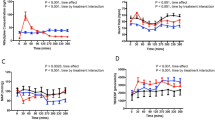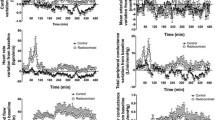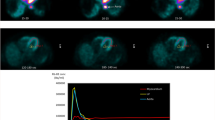Summary
Myocardial availability of drug, using metoprolol as a tracer, in acutely ischemic myocardium in the area of the left circumflex (LCX) coronary artery was compared following standard intravenous (IV) administration and after coronary sinus retroinfusion. Seven open-chest farm pigs were subjected to a 21-minute occlusion of the LCX coronary artery. All animals received simultaneous IV tritium-labeled metoprolol (0.2 mg/kg) and unlabeled metoprolol (0.2 mg/kg) retrogradely into the coronary sinus. The drug administration was starded after 1 minute of coronary artery occlusion and continued for 5 minutes. Intravenously administered metoprolol resulted in a higher peak plasma concentration of metoprolol (382±52 nmol/l) than coronary sinus retroinfusion (276±47 nmol/l). The nonischemic myocardial metoprolol concentration was of similar magnitude (393–454 pmol/g), whether infused IV or into the coronary sinus. Coronary sinus retroinfusion, however, resulted in a substantial accumulation of metoprolol in the ischemic myocardium (2887–5863 pmol/g). Coronary sinus retroinfusion resulted in a pronounced and specific accumulation in the ischemic myocardium in the territory of the LCX coronary artery.
Similar content being viewed by others
References
Miyazaki A, Hatori N, Tadokoro H, et al. More rapid thrombolysis with coronary venous retroinfusion of streptokinase compared with intravenous administration. An experimental study in canines. Eur Heart J 1990;11:936–944.
Wappel M, Zalewski A, Savage M, et al. Myocardial salvage after regional beta-adrenergic blockade. Am Heart J 1989;117:37–42.
Karaguzian HS, Ohta M, Drury JK, et al. Coronary venous retroinfusion of procainamide: A new approach for the management of spontaneous and inducible sustained ventricular tachycardia during myocardial infarction. J Am Coll Cardiol 1986;7:551–563.
Hatori N, Tadokoro H, Satomura K, et al. Beneficial effects of coronary venous retroinfusion but not left atrial administration of superoxide dismutase on myocardial necrosis in pigs. Eur Heart J 1991:12:442–450.
Hatori N, Miyazaki A, Tadokoro H, et al. Beneficial effects of coronary venous retroinfusion of superoxide dismutase and catalase on reperfusion arrhythmias, myocardial function and infarct size in dogs. J Cardiovasc Pharmacol 1989;14:396–404.
Rydén L, Tadokoro H, Sjöquist P-O, et al. Pronounced accumulation of metoprolol in ischemic myocardium following coronary venous retroinfusion. J Cardiovasc Pharmacol 1990;15:22–28.
Rydén L, Tadokoro H, Sjöquist P-O, et al. Pharmacokinetics analysis of coronary venous retroinfusion; A comparison with antegrade coronary arterial drug administration using metoprolol tartrate as a tracer. J Am Coll Cardiol 1991;18:603–612.
Glantz SA. Primer of biostatics, 2nd ed. New York: McGraw-Hill, 1987:287–330.
Wallenstein S, Zucker CL, Fleiss JL. Some statistical methods useful in circulation research. Circ Res 1980;47:1–9.
Meesmann M, Karaguzian HS, Ino T, et al. Selective perfusion of ischemic myocardium during coronary venous retro-infusion: A study of the causative role of venoarterial and venoventricular pressure gradients. J Am Coll Cardiol 1987;10:887–897.
Drury JK, Yamazaki S, Fishbein MC, et al. Synchronized diastolic coronary venous retroperfusion: Results of a pre-clinical safety and efficacy study. J Am Coll Cardiol 1985;6:328–335.
Corday E, Kar S, Drury JK, et al. Coronary venous retroperfusion for support of ischemic myocardium. Cardiovasc Rev Rep 1988;9:50–53.
Gott VL, Gonzalez JL, Zuhdi MN, et al. Retrograde reperfusion of the coronary sinus for direct aortic surgery. Surg Gynecol Obstet 1957;104:319–28.
Hammond GL, Davies AL, Austen WG. Retrograde coronary sinus perfusion: A method of myocardial protection in the dog during left coronary artery occlusion. Ann Surg 1967;166:39–47.
Mohl W, Glogar DH, Mayr H, et al. Reduction of infarct size induced by pressure-controlled intermittent coronary sinus occlusion. Am J Cardiol 1984;53:923–928.
Berdeaux A, Farcot JC, Bourdarias JP, et al. Effects of diastolic synchronized retroperfusion on regional coronary blood flow in experimental myocardial ischemia. Am J Cardiol 1981;47:1033–1040.
Ablad B, Abrahmsson T, Adler G, et al. Cardiac anti-ischemic effect of metoprolol; role of beta-blockade within the ischemic region. J Cardiovasc Pharmacol 1987;10: S117–125.
Author information
Authors and Affiliations
Rights and permissions
About this article
Cite this article
Hatori, N., Sjöquist, PO., Regårdh, C. et al. Pharmacokinetic analysis of coronary sinus retroinfusion in pigs. Cardiovasc Drug Ther 5, 1005–1010 (1991). https://doi.org/10.1007/BF00143528
Issue Date:
DOI: https://doi.org/10.1007/BF00143528




